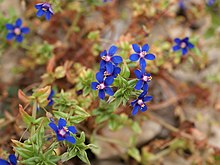Lysimachia foemina is commonly known as blue pimpernel[1] or poor man's weatherglass, and was formerly called Anagallis foemina. It is a low-growing annual herbaceous plant in the genus Lysimachia of the family Primulaceae. In a comparison of DNA sequences, L. foemina was shown to be most closely related to L. monelli.[2] It had been thought by many to be closest to L. arvensis, and some authors had even included L. foemina as a subspecies of L. arvensis, as Anagallis arvensis subsp foemina.[3] These three species (L arvensis, L foemina and L monelli) were among several transferred from Anagallis to Lysimachia in a 2009 paper.[4]
| Lysimachia foemina | |
|---|---|

| |
| Lysimachia foemina | |
| Scientific classification | |
| Kingdom: | Plantae |
| Clade: | Tracheophytes |
| Clade: | Angiosperms |
| Clade: | Eudicots |
| Clade: | Asterids |
| Order: | Ericales |
| Family: | Primulaceae |
| Genus: | Lysimachia |
| Species: | L. foemina
|
| Binomial name | |
| Lysimachia foemina (Mill.) Manns & Anderb.
| |
| Synonyms | |
| |
Etymology
editThe previous genus name Anagallis derives from the Greek words ana meaning "again" and agallein meaning "to delight in", possibly referring to the fact that these plants produce flowers twice in a year and the flowers open whenever the sun strikes them.[5] The species epithet foemina means "female" and refers to the small size of the plant and the gentleness of its appearance. The common name refers to the fact that the flowers close at the approaching of the bad weather.[6]
Description
editLysimachia foemina has weak, square and sprawling stems growing to about 5–18 centimetres (2.0–7.1 in) long,[7] which bear bright green sessile leaves in opposite pairs. The leaves are usually lance-shaped about 7–11 mm (0.28–0.43 in) wide and 12–16 mm (0.47–0.63 in) long, although some leaves, especially the lowest, may be ovate.
The small flowers are about 8 mm (0.31 in) in diameter, have a short stalk, are produced in the leaf axils and are usually blue. They have five lanceolate sepals and five petals. The filaments are about 3 mm (0.12 in) long, with showy yellow anthers. The flowering period extends from April to October.[7] The hermaphroditic flowers are pollinated by insects (entomogamy). The fruit is a spherical capsule up to 4 mm (0.16 in) in diameter containing about 15 seeds.[7]
This species is very similar to the related Lysimachia arvensis, and has been regarded as a subspecies of L arvensis. In 2007, a molecular phylogenetic study showed that Lysimachia foemina is more closely related to Lysimachia monelli than to Lysimachia arvensis, and should be treated as a separate species.[2]
Confusable Species
editLysimachia foemina is widely confused with Lysimachia loeflingii (formerly Lysimachia arvensis var. azurea/caerulea). They can be distinguished by the large fruiting capsule's conspicuous veins (loeflingii 5-6 veined, foemina many more), petal shape/glanding (foemina narrow, separated petals with sparse (3)4-celled glands at tip (final cell ellipsoid), loeflingii usually broad touching petals with many 3-celled glands (final cell globose) (see photo in Stace[8])), flower stalk (foemina most stalks up to length of under-flower leaves, loeflingii often much longer), leaf shape/colour (foemina upper leaves rather narrow and usually dark, loeflingii broader and usually lighter).[8][9][10]
Distribution
editThis cosmopolitan plant is native to central and southern Europe and has been introduced in Africa, northern and eastern Asia, North and South America and western Australia.[7]
Habitat
editIt grows in scrub, uncultivated soils and grasslands. It prefers dry, nutrient- and lime-rich soils, at an altitude of 0–1,200 metres (0–3,937 ft) above sea level.[7]
References
edit- ^ Clive Stace, New Flora of the British Isles 4th edition 2019, p 552
- ^ a b Manns, Ulrika; Anderberg, AA (Dec 2007). "Relationships of Anagallis foemina and Anagallis arvensis (Myrsinaceae): New insights inferred from DNA sequence data". Molecular Phylogenetics and Evolution. 45 (3): 971–980. doi:10.1016/j.ympev.2007.07.022. PMID 17869544.
- ^ Clapham, Tutin, & Warburg: Flora of the British Isles, 2nd edition, page 435
- ^ Manns, Ulrika; Anderberg, Arne A. (July 2009). "New combinations and names in Lysimachia (Myrsinaceae) for species of Anagallis, Pelletiera and Trientalis". Willdenowia. 39 (1): 49–54. doi:10.3372/wi.39.39103. JSTOR 20699148.
- ^ Malta Wild Plants
- ^ Trek Nature
- ^ a b c d e Pignatti S. - Flora d'Italia – Edagricole – 1982. Vol. II, pag. 291
- ^ a b New Flora of the British Isles, ed. 4 and also 3, C. Stace
- ^ Davis. Flora of Turkey and the East Aegean Islands, vol. 6.
- ^ Tutin. Flora of the British Isles, ed. 3.